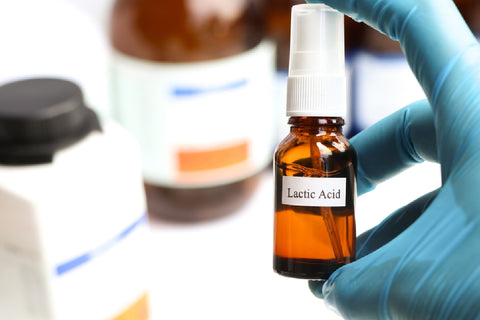Lactic Acid For Ingrown Hairs & Razor Bumps - Get Silky & Smooth Skin
If you've ever experienced ingrown hairs or razor bumps, you know how frustrating and uncomfortable they can be. These conditions occur when hair grows back into the skin instead of upward and outward, causing inflammation, redness, and sometimes infection. Worry not, as Lactic Acid For Ingrown Hair & Razor Bumps can help. Lactic acid is an alpha-hydroxy acid that can help exfoliate the top layer of dead skin cells, releasing trapped hairs that are causing ingrown hair or razor bump.

In this blog, we will explore the benefits of using lactic acid for ingrown hairs and razor bumps, how it works, and how to use it safely and effectively. We will also provide tips on preventing ingrown hairs and razor bumps from occurring in the first place. It also helps to soften the skin and hair, making it easier for the hair to grow out of the skin. So sit back, relax, and let's dive into the world of lactic acid and its benefits for your skin!
Does Lactic Acid Work For Ingrown Hairs?
Lactic acid is often used to treat various skin conditions, including ingrown hairs. Ingrown hairs occur when hair grows back into the skin instead of upward and outward, causing inflammation, redness, and sometimes even infection. Lactic acid, an alpha-hydroxy acid, works by exfoliating the top layer of dead skin cells, which can help release trapped hairs that are causing the ingrown hair.

It also helps to soften the skin and hair, making it easier for the hair to grow out of the skin. To use lactic acid for ingrown hairs, you can apply a product containing lactic acids, such as a lotion or serum, directly to the affected area. Exfoliating the area with a gentle scrub or brush is also helpful before applying the lactic acid product.
Does Lactic Acid Work For Razor Bumps?
Lactic acid can effectively treat razor bumps, also known as pseudofolliculitis barbae. Razor bumps occur when shaved hair grows back into the skin, causing inflammation, redness, and bumps.

As an alpha-hydroxy acid, lactic acid works by exfoliating the top layer of dead skin cells, which can help to release trapped hairs that are causing razor bumps. It also helps to soften the skin and hair, making it easier for the hair to grow out of the skin.
How To Use Lactic Acid For Ingrown Hairs?
Ingrown hair is a common yet frustrating problem to deal with. If you wish to remove your ingrown hairs smoothly and without any pain, use lactic acid for ingrown hairs.

Ingredients
- Lactic Acid - ½ Teaspoon
- Granulated Salt Or Sugar - 1/4 Cup
- Sweet Almond Oil - 2-3 Tablespoons
- Lavender Essential Oil - 3-5 Drops
How To Make Lactic Acid For Ingrown Hairs
Step 1: Mix the sugar or salt with the carrier oil and lactic acid in a small bowl until it forms a paste.
Step 2: If desired, add a few drops of lavender essential oil and stir to combine.
Step 3: Apply the scrub to the affected area using gentle circular motions, being careful not to scrub too hard, which can irritate the skin.
Step 4: Rinse the area with warm water and pat dry with a clean towel.
Step 5: Apply a moisturizer to the area to help soothe the skin.
Step 6: This scrub can be used once or twice a week, depending on your skin type and how often you experience ingrown hairs.
Step 7: Additionally, it's important to follow proper shaving techniques to prevent ingrown hairs from occurring in the first place.
Conclusion
Lactic Acid for ingrown hairs works like a miracle. If you're looking for a lactic acid product on your skin, consider trying VedaOils. Incorporating a lactic acid product, like VedaOils, into your skincare routine can be a helpful step in reducing the appearance of ingrown hairs and razor bumps and achieving smoother, healthier-looking skin.
FAQs: Lactic Acid For Ingrown Hairs & Razor Bumps
Q1: Is Lactic Acid Good For Ingrown Hair?
Ans: Lactic acid can aid in removing dead skin cells from the skin's surface, eliminating ingrown hairs and minimising the risk of new ones.
Q2: Can You Put Lactic Acid On An Ingrown Hair Cyst?
Ans: Applying lactic acid to an ingrown hair cyst aids in the growth of the hair follicle and the removal of dead cells. However, employing natural substances with lactic acid to form a paste for your ingrown hair cyst is recommended.
Q3: Can You Put Lactic Acid On Your Pubic Area?
Ans: Yes, you can make a scrub to apply to your pubic area, rub for a minute, and then wipe away the ingrown hair with a washcloth.
Q4: Can I Use Lactic Acid After Shaving?
Ans: Yes, exfoliating your face with Lactic Acid after shaving helps to prevent razor bumps and improves the general texture of your face.
Q5: How Do You Dilute Lactic Acid For Razor Bumps?
Ans: You can use any natural carrier oil to dilute lactic acid for razor bumps. Use the given recipe for the best results.
You May Also Like:
Buy Products
Related Articles
-
 DIY Hair Pomade - Easy Homemade Recipe With & Without Beeswax
DIY Hair Pomade - Easy Homemade Recipe With & Without Beeswax -
 DIY Glycerin Moisturizer – 3 Natural Homemade Recipes For Face
DIY Glycerin Moisturizer – 3 Natural Homemade Recipes For Face -
 DIY Cleansing Oil - Best Homemade Recipe For All Skin Types
DIY Cleansing Oil - Best Homemade Recipe For All Skin Types -
 How to Make Marble Candles | DIY Marble Pillar Candle
How to Make Marble Candles | DIY Marble Pillar Candle -
 DIY Tanning Oil - Best Homemade Recipes For Tan Removal
DIY Tanning Oil - Best Homemade Recipes For Tan Removal -
 Homemade Mustache Wax: Best DIY Recipe With Natural Ingredients
Homemade Mustache Wax: Best DIY Recipe With Natural Ingredients
Disclaimer :- This article is intended for informational and educational purposes only and should not be considered a substitute for professional medical advice. For specific health concerns or treatment, please consult your personal physician. The article's editor, writer, and VedaOils organization do not assume any responsibility for any health outcomes resulting from the information provided. Readers are strongly encouraged to seek advice from their physician before acting on any recommendations made in these articles.

















 Sign in
Sign in Register now
Register now My Reward Points
My Reward Points









